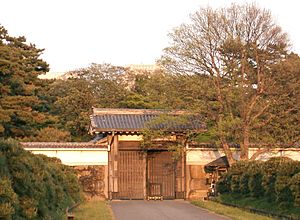Hattori Hanzō facts for kids
Quick facts for kids Hattori Hanzō |
|
|---|---|
| 服部 半蔵 | |
 |
|
| Leader of Iga Ninja | |
| In office 1557–1597 |
|
| Succeeded by | Hattori Masanari |
| Personal details | |
| Born | Hattori Masanari 服部 正成 c. 1542 Mikawa Province (now Iga-chō, Okazaki, Aichi) |
| Died | January 2, 1597 (aged 54-55) Edo, Musashi province |
| Relations | Hattori Yasunaga, 1st-Hanzō (father) Hattori Masanari, 3rd-Hanzō (son) |
| Military service | |
| Nickname(s) | "Demon Hanzō" |
| Allegiance | |
| Battles/wars | Attack on Udo Castle Siege of Kaminogō Castle Siege of Kakegawa Battle of Anegawa Battle of Mikatagahara Battle of Komaki and Nagakute Siege of Odawara |
Hattori Hanzō (服部 半蔵, c. 1542 – January 2, 1597) was a very famous ninja from the Sengoku period in Japan. He was also known as the Second Hanzō. People nicknamed him Oni no Hanzō (鬼の半蔵, Demon Hanzō) because he was so brave and fearless.
Hanzō worked for the powerful Tokugawa clan. He is famous for helping Tokugawa Ieyasu become the ruler of a united Japan. Hanzō was a master of sword fighting and a clever planner.
Contents
Early Life of a Ninja
Hattori Hanzō was born around 1542 in Mikawa Province. His father, Hattori Yasunaga, was also called the First Hanzō. His real name was Hattori Masanari. He became known as the Second Hanzō to tell him apart from his father.
Hanzō's family came from Iga Province, a place famous for its ninja. Even though he was born in Mikawa, he often visited Iga. When he was just 15 years old, Hanzō fought in his first battle. It was a night attack during the siege of Udo Castle in 1557. He led 70 Iga ninja in this fight.
Serving Lord Ieyasu
Hanzō played a huge part in helping Tokugawa Ieyasu become a powerful leader. He helped Ieyasu defeat the Imagawa clan. In 1562, Hanzō successfully rescued Ieyasu's wife and son. They had been held hostage by the Imagawa clan at Kaminogo Castle. Later, in 1569, he helped attack Kakegawa Castle, also against the Imagawa clan.
Hanzō fought bravely in many important battles. These included the Battle of Anegawa in 1570 and the Battle of Mikatagahara in 1572. During the Battle of Mikatagahara, Hanzō led an Iga ninja unit of 150 men. He even captured a spy from the Takeda army. When Takeda troops attacked Totomi, Hanzō fought back with only 30 warriors.
His most important help came in 1582. After the death of Oda Nobunaga, Ieyasu was in danger. Hanzō guided Ieyasu safely across Iga territory. He led 300 ninja guards to protect his lord. This journey helped Ieyasu escape danger and reach safety.
Hanzō continued to serve Ieyasu in later battles. In 1584, he fought at the Battle of Komaki and Nagakute. He commanded 100 warriors there. In 1590, Hanzō also served during the Siege of Odawara. For his great service, he received many rewards and more responsibilities. Ieyasu trusted Hanzō to lead many Iga ninja.
Towards the end of his life, Hanzō became a monk. He took the name "Sainen." He built a temple called Sainenji. This temple was partly named after him. It also honored Tokugawa Ieyasu's older son, Tokugawa Nobuyasu. Nobuyasu had faced a difficult situation. Hanzō was asked to perform a sad duty for Nobuyasu. But he refused, showing his deep loyalty to his lord's family. Ieyasu was touched by Hanzō's loyalty. He said, "Even a demon can shed tears."
Hanzō's Final Years
Hattori Hanzō passed away in 1597, when he was about 54 or 55 years old. There are two main ideas about how he died.
One story says he was killed by a rival samurai named Fūma Kotarō. Hanzō supposedly chased Kotarō to the Inland Sea. Kotarō then trapped Hanzō and his men in a narrow channel. He used oil to set the water on fire. The other idea is that Hanzō lived out his last days as a monk in Edo. He then died from an illness.
Hanzō's Lasting Legacy
Hanzō was a legendary samurai leader. He commanded 200 Iga warriors. Over time, stories about him grew. Some tales even say he had supernatural powers. These included being able to teleport, move things with his mind, or see the future.
After Hanzō's death, his son took over. His son was also named Masanari, and he became the Third Hanzō. The name Hanzō was actually passed down through the leaders of the Hattori family. This means there were five people known as Hattori Hanzō throughout history.
Even today, you can find parts of Hanzō's legacy in Japan. The Tokyo Imperial Palace has a gate called Hanzō's Gate (Hanzōmon). The Tokyo Metro Hanzōmon Line subway is also named after this gate. Hanzō's house used to be near this gate. The area outside the gate was even called Iga-chō ("Iga Town") until 1943.
Hanzō's remains are buried at the Sainen-ji temple cemetery in Yotsuya, Tokyo. The temple also keeps his favorite spear and his special battle helmet. The spear was originally very long, about 14 feet. Ieyasu gave it to Hanzō. Hanzō later gave it to the temple as a gift. Sadly, it was damaged during the bombing of Tokyo in 1945.

See also
 In Spanish: Hattori Hanzō para niños
In Spanish: Hattori Hanzō para niños
- Fūma Kotarō


